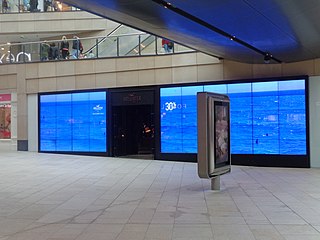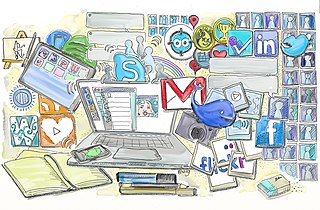Face time is an English idiom for direct personal interaction or contact between two or more people at the same time and physical location. Face time therefore occurs in "real life" and contrasts primarily with interaction or contact which occurs over distance (e.g., via telephone) and/or electronically (e.g., via email, instant messaging, e-commerce, social media, or computer simulations).
The term was originally a colloquialism. However, it has entered the vernacular with the increasing number of people throughout the world who commonly and extensively rely on telecommunications and the Internet for personal and business communication.
An internet relationship is a relationship between people who have met online, and in many cases know each other only via the Internet. Online relationships are similar in many ways to pen pal relationships. This relationship can be romantic, platonic, or even based on business affairs. An internet relationship is generally sustained for a certain amount of time before being titled a relationship, just as in-person relationships. The major difference here is that an internet relationship is sustained via computer or online service, and the individuals in the relationship may or may not ever meet each other in person. Otherwise, the term is quite broad and can include relationships based upon text, video, audio, or even virtual character. This relationship can be between people in different regions, different countries, different sides of the world, or even people who reside in the same area but do not communicate in person.

Sales are activities related to selling or the number of goods sold in a given targeted time period. The delivery of a service for a cost is also considered a sale. A period during which goods are sold for a reduced price may also be referred to as a "sale".

The career is an individual's metaphorical "journey" through learning, work and other aspects of life. There are a number of ways to define career and the term is used in a variety of ways.

Physical intimacy is sensuous proximity or touching. It is an act or reaction, such as an expression of feelings, between people. Examples of physical intimacy include being inside someone's personal space, holding hands, hugging, kissing, caressing and sexual activity. Physical intimacy can often convey the real meaning or intention of an interaction in a way that accompanying speech cannot do. Physical intimacy can be exchanged between any people but as it is often used to communicate positive and intimate feelings, it most often occurs in people who have a preexisting relationship, whether familial, platonic or romantic, with romantic relationships having increased physical intimacy. Several forms of romantic touch have been noted including holding hands, hugging, kissing, cuddling, as well as caressing and massaging. Physical affection is highly correlated with overall relationship and partner satisfaction.
Proxemics is the study of human use of space and the effects that population density has on behavior, communication, and social interaction.
Real life is a phrase used originally in literature to distinguish between the real world and fictional, virtual or idealized worlds, and in acting to distinguish between actors and the characters they portray. It has become a popular term on the Internet to describe events, people, activities, and interactions occurring offline; or otherwise not primarily through the medium of the Internet. It is also used as a metaphor to distinguish life in a vocational setting as opposed to an academic one, or adulthood and the adult world as opposed to childhood or adolescence.
Rapport is a close and harmonious relationship in which the people or groups concerned are "in sync" with each other, understand each other's feelings or ideas, and communicate smoothly.

Nonverbal communication (NVC) is the transmission of messages or signals through a nonverbal platform such as eye contact (oculesics), body language (kinesics), social distance (proxemics), touch (haptics), voice (paralanguage), physical environments/appearance, and use of objects. When communicating, we utilize nonverbal channels as means to convey different messages or signals, whereas others can interpret these message. The study of nonverbal communication started in 1872 with the publication of The Expression of the Emotions in Man and Animals by Charles Darwin. Darwin began to study nonverbal communication as he noticed the interactions between animals such as lions, tigers, dogs etc. and realized they also communicated by gestures and expressions. For the first time, nonverbal communication was studied and its relevance questioned. Today, scholars argue that nonverbal communication can convey more meaning than verbal communication.
Theories of technological change and innovation attempt to explain the factors that shape technological innovation as well as the impact of technology on society and culture. Some of the most contemporary theories of technological change reject two of the previous views: the linear model of technological innovation and other, the technological determinism. To challenge the linear model, some of today's theories of technological change and innovation point to the history of technology, where they find evidence that technological innovation often gives rise to new scientific fields, and emphasizes the important role that social networks and cultural values play in creating and shaping technological artifacts. To challenge the so-called "technological determinism", today's theories of technological change emphasize the scope of the need of technical choice, which they find to be greater than most laypeople can realize; as scientists in philosophy of science, and further science and technology often like to say about this "It could have been different." For this reason, theorists who take these positions often argue that a greater public involvement in technological decision-making is desired.
Face is a class of behaviors and customs, associated with the morality, honor, and authority of an individual, and its image in social groups.

A social networking service or SNS is a type of online social media platform which people use to build social networks or social relationships with other people who share similar personal or career content, interests, activities, backgrounds or real-life connections.

Parasocial interaction (PSI) refers to a kind of psychological relationship experienced by an audience in their mediated encounters with performers in the mass media, particularly on television and on online platforms. Viewers or listeners come to consider media personalities as friends, despite having no or limited interactions with them. PSI is described as an illusory experience, such that media audiences interact with personas as if they are engaged in a reciprocal relationship with them. The term was coined by Donald Horton and Richard Wohl in 1956.
A personal network is a set of human contacts known to an individual, with whom that individual would expect to interact at intervals to support a given set of activities. In other words, a personal network is a group of caring, dedicated people who are committed to maintain a relationship with a person in order to support a given set of activities. Having a strong personal network requires being connected to a network of resources for mutual development and growth.
"Frenemy" is an oxymoron and a portmanteau of "friend" and "enemy" that refers to "a person with whom one is friendly, despite a fundamental dislike or rivalry" or "a person who combines the characteristics of a friend and an enemy".

Social information processing theory, also known as SIP, is a psychological and sociological theory originally developed by Salancik and Pfeffer in 1978. This theory explores how individuals make decisions and form attitudes in a social context, often focusing on the workplace. It suggests that people rely heavily on the social information available to them in their environments, including input from colleagues and peers, to shape their attitudes, behaviors, and perceptions.

Interpersonal communication is an exchange of information between two or more people. It is also an area of research that seeks to understand how humans use verbal and nonverbal cues to accomplish several personal and relational goals. Communication includes utilizing communication skills within one's surroundings, including physical and psychological spaces. It is essential to see the visual/nonverbal and verbal cues regarding the physical spaces. In the psychological spaces, self-awareness and awareness of the emotions, cultures, and things that are not seen are also significant when communicating.
Social cues are verbal or non-verbal signals expressed through the face, body, voice, motion and guide conversations as well as other social interactions by influencing our impressions of and responses to others. These percepts are important communicative tools as they convey important social and contextual information and therefore facilitate social understanding.
A clique, in the social sciences, is a group of individuals who interact with one another and share similar interests rather than with others. Interacting with cliques is part of normative social development regardless of gender, ethnicity, or popularity. Although cliques are most commonly studied during adolescence and middle childhood development, they exist in all age groups. They are often bound together by shared social characteristics such as ethnicity and socioeconomic status. Examples of common or stereotypical adolescent cliques include athletes, nerds, and "outsiders".

Face-to-face interaction is social communication carried out with other present individuals without any mediating technology. It is defined as the mutual influence of individuals’ direct physical presence with their body language and verbal language. It is one of the basic elements of a social system, forming a significant part of socialization and experience throughout an individual's lifetime. It is also central to the development of groups and organizations composed of those individuals. Face-to-face interaction not only allows people to communicate more directly, but has been shown to improve mental health and can reduce various mental illnesses, most commonly, depression and anxiety.